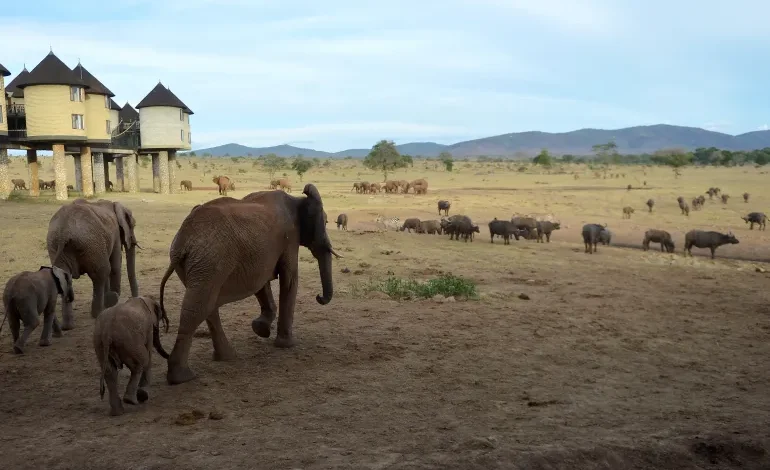Chilli bombs and honeybees: Weapons in Tanzania’s human-elephant conflict

Mwana Athumani Msemo’s homestead sits encased in the undulating grasslands that surround Mount Kilimanjaro, an area so quiet and remote that clucking and bleating from her chicken and goat farm are the only sounds to be heard for kilometres.
The landscape, with its crisp air and lush greens, holds glorious beauty. But for Msemo, it also holds ever-present anguish. It was somewhere in this wilderness that her husband took their cattle out to graze one afternoon two years ago and never returned. By the time the village search team found him at the end of a long trail of elephant footprints, it was dark and he had been dead for hours – a gaping hole where his stomach once was.
“He left me with five kids,” the 55-year-old said in Swahili, sitting in her living room, her hands over her face. A sob escaped her pursed lips even as she pulled the scarf hanging on her head across her mouth to stifle it.
“When he was here, things were easy, the cattle were there. Now, the cattle are no longer there. The kids are growing – they’ve finished school but they don’t have jobs.”
Across Tanzania, an East African country bursting with jungles and wildlife, expanding human populations are encroaching more and more on wildlife spaces, putting people on a collision course with roaming animals in increasingly fatal events.
In many rural communities like Ngulu Kwakoa, which sits near a wildlife corridor, the most common are clashes with elephants – animals that must migrate in search of food and that can turn from gentle giants to charging aggressors in an instant.
The giant mammals are a massive pain for farmers, too.
Across Msemo’s back yard, past the simple grave where her husband now rests, and down a steep path, her neighbour’s maize farm lies in ruins.The animals breached a fence built with spiky branches and went straight for the nearly matured corn crops. In the rows of bean crops that had just started sprouting flowers, giant footsteps were still visible.
“I was expecting to harvest it in two weeks,” Mdee said. Raids like these happen almost yearly, but the hurt every time is fresh, she said. “I’ve lost it all.”
A continent-wide problem
Across the continent, animal clashes with villagers close to national parks or wildlife migratory routes have been rising in recent years, researchers say.
As Africa’s population leaped by one billion between 1950 and 2020, elephant populations have fallen and recovered at the same time, creating competition for food, water and space.
A worsening drought that has shrunk food and water resources for elephants across East Africa has also pushed elephants out further from their designated parks and protected areas, forcing them into human settlements like Ngulu Kwakoa.
For many, elephants elicit fierce affection. Their numbers plummeted in Africa from 1.3 million in the 1970s to 415,000, largely due to poaching for their valuable ivory tusks. Countries have since cracked down on poachers but drought, habitat loss and conflict with humans have emerged as threats, meaning elephant species continue to be endangered.
But for those living close to them, the megaherbivores draw anger. Elephants gobble up to 450kg of forage a day, drink up to 190 litres of water and need space to roam.
However, with more villages, farms, roads and other infrastructure propping up in their territory and fragmenting their habitat, they are forced into human territories – often those of poor rural dwellers who depend on subsistence farming for their survival. A single raid on a farm hosting elephant favourites like maize or juicy tomatoes could wipe out a year’s worth of food.
Often, villagers grazing their cattle or looking for firewood also encounter the animals in the wilderness. Although usually peaceful, elephants can attack people when they feel threatened, tossing their victims in the air or trampling and crushing them.
To protect themselves, aggrieved villagers have been known to hunt down the mammals or poison water and food sources in anticipation of a raid.
Countries with the biggest elephant populations are also among the worst hit by clashes, including Zimbabwe, with 100,000 elephants. Poor governance and sanctions in the Southern African country make it a “peak conflict site”, King said, with authorities there lacking funds to roll out strategies to separate wildlife corridors from settlements.
Tanzania (with 60,000 elephants) and neighbouring Kenya (with 35,000) are also badly hit. In Kenya, authorities report having to kill between 50 to 120 elephants a year because they have attacked humans.
Are there possible solutions?
Finding solutions to elephant-human conflicts must focus on expanding and freeing up wildlife corridors, so the animals can roam more freely without encountering humans, analysts say.
“These are the main things, and on the side, we can look for mitigation measures to help people live more peacefully with the animals,” said King.
In Tanzania, some have taken to filling up rubber condoms with chilli powder – a spice the elephants hate – and hauling it at raiding invaders like bombs. Others use sound as a means of distraction, beating loudly on steel buckets at intervals to scare elephants away.
Some six hours west of the Kilimanjaro region, communities are scaling another method pioneered by King herself, with the help of an unlikely character – tiny honeybees.
In her research, King found that elephants are mightily scared of bees. Stings on the sensitive insides of their trunks, the sides of their mouths, and behind their ears are so painful, that the intelligent animals know to scram when they hear the buzz of a hive.
Playing on that fear, King came up with the idea to position bees strategically around farms and realised that it could deter elephants from going ahead with raids. After testing the method in Kenya, the researcher created a manual and published it so that conservationists from Tanzania to India are now making use of it.
In Upper Kitete, a village bordering the majestic Ngorongoro Conservation Area, elephants are regular visitors. But since 2019 when conservationists have been hanging up beehives on wooden poles and then ringing them around farms like a fence, fewer of the mammals have been visiting, said John Massay, who grew up there and now collects data for Wild Survivors
On a recent evening, Massay set out to inspect progress on one farm.
The beehive boxes hanging on wires stretched into the distance, guarding the sprouting bean and millet crops. A tractor hummed nearby as he inspected first a camera trap and then the bee boxes.
“The elephant raids have reduced but they haven’t stopped totally,” the researcher said. Still, the gains have been significant. Monthly raids went from 62 in 2020 to 15 in 2023, according to the team’s data.
At least one elephant had breached a part of the fence just hours ago and stamped through the farms, Massay said, pointing to giant footprints in the dark soil. Often, a stubborn adult male wanders onto a fenced farm, heedless of a possible bee attack. That’s because solitary males have fewer warning gears and are likely to take risks, as opposed to the reasoned and safe decisions that a family led by a matriarch would take.
, a nonprofit based in the UK.










